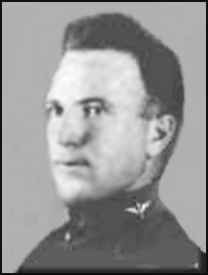
Collection of Walter E. Lees
-1943 |
 |
||
Collection of Walter E. Lees |
via email from John Davis, 7-5-06 Thanks for posting this interesting information. I found your site through search of Corkille. My wife's grandfather was Col. John D. Corkille, who flew in WW1, the 1923 Bendix, the ill fated Martin Bomber flight to Alaska and was lead test pilot for the development of the B-17. He died in N Africa in '43 of a heart attack as he shipped out for the states to get his first star. Interestingly enough, his middle name was Davis. We named our first son John Corkille Davis. John Davis |
via email from Lino Zapanta, 11-9-06 I thought you'd be interested in this input. On June 30, 1928, the 6th Photographic Section was sent on another mission on the request of the American Red Cross and the Philippine Weather Bureau, to photograph the crater and the lava flow of Mt. Mayon which had just erupted. The job was given to Lt. John D. Corkille using a Loening COA-1. Goddard was the photographer of the mission in which he brought two of his aerial cameras, a 16-mm home movie outfit and life preservers. It was a rough ride to the Bicol Region with thunderstorms along the way forcing Corkille to fly to higher altitude through the gaps in the clouds. Over at the volcano area, he could not locate a break in the cloud to descend and when he did they were met by thick sulphuric clouds that jarred the aircraft causing equipment on board to be strewn around. Then they spotted the crater of the volcano protruding about 500 ft above the clouds allowing Goddard to take a few spectacular shots of flames, clouds of ashes and lava flows. The early sunset of the western seacoast prevented Goddard from taking more photographs. They headed to Legaspi and landed in the bay where hundreds of refugees were settled on the beach area. The following day rewarded them with a calm and clear weather that allowed them many more shots of the volcano before they headed back to Manila. Goddard’s photos found print in the newspapers the following day. The success of the mission was largely due to the experienced flying of Corkille which was an accumulation of his daring exploits as a World War I flyer and as an air racer (6th placer in the Pulitzer Trophy Race of 1923). Best regards - Lino Zapanta |
|
Speed and Time Chart |
|
Place Pilot 1. Lieut. A. J. Williams, Navy 2. Lieut. H. J. Brow, Navy 3. Lieut. L. H. Sanderson, Marine Corps 4. Lieut. S. W. Callaway, Navy 5. Lieut. Walter Miller, Army 6. Lieut. J. D. Corkille, Army 7. Lieut. Alexander Pearson, Army Forced Down Before Race |
Speed 243.67 241.78 230.06 230.00 218.91 216.45 |
Time 30:36:01 30:50:30 32:24:59 32:25:14 34:03:73 34:26:90 |
|
Lieuts. Callaway and Sanderson flew Wright fighter planes with 700-horsepower motors. Lieuts. Williams
and Brow flew Curtiss R2C1 planes with 460-horsepower motors. Lieuts. Miller and Corkille flew Curtiss racers with 400-horsepower motors. Lieut Pearson was to
have flown a Verville-Sperry monoplane with 400-horsepower motor and folding landing gear, the only monoplane in the race. A striking feature shown by the chart is the consistent way in which the pilots maintained speed, even in the case of Lieut. Miller, who had mechanical trouble, which made his plane hard to control. There was a difference in elapsed time of only 3 minutes and 50.89 seconds between the winner and the last man for the full distance of 124.28 miles. |
|
"Approaching the pylons," he said, "the earth seemed to be quivering in front of me. As I neared the pylons, the only way I could see them was out of the corner of my eye. On my second lap, I could not see the railroad and was again thrown off my course. Finally, on the third lap, I succeeded in getting my hand to my goggles for a second to readjust them and was more comfortable for the remainder of the race." Lieut. Corkille's statement is borne out by his speed in his various laps. His first was completed at 210.58 miles an hour, the second at 216.47 miles an hour, the third at 215.01 miles an hour and the last lap was stepped up to 216.45 miles an hour. During the race, the top of Lieut. Corkille's leather helmet was stripped off by the terrific wind. To Read the Entire Article, click on: Pulitzer Trophy Race |
|
|
|
Combat Chronology March 1943 03/22/43 Ninth AF "Col John D Corkille succeeds Gen Kauch in cmd of IX ASC. During 21/22 Mar, RAF Liberators, under IX BC, bomb Naples. During the day, B-25's hit Gabes area, bombing road junction, motor transport, and troop concentration. P-40's fly 5 escort missions during the day. British ground forces, after expanding Oued Zigzaou bridgehead during 21/22 Mar, are severely handicapped by heavy rain. Enemy counterattack forces 50th Div to give ground." You can access the page by clicking on the title above. |
|
|
|
You can access the page by clicking on the title above. If time permits, you might like to put "Corky Larson" into Google just to get some idea of the fascinating life and career of John's daughter. |
|
John Corkille died in North Africa in 1943 of a heart attack as he shipped out for the states to get his
first star. |
|
please contact me. E-mail to Ralph Cooper Back 

|